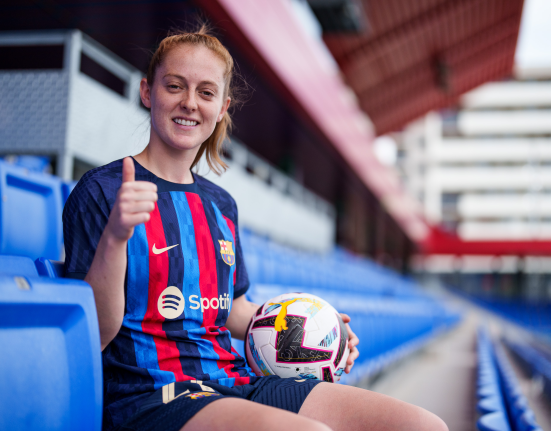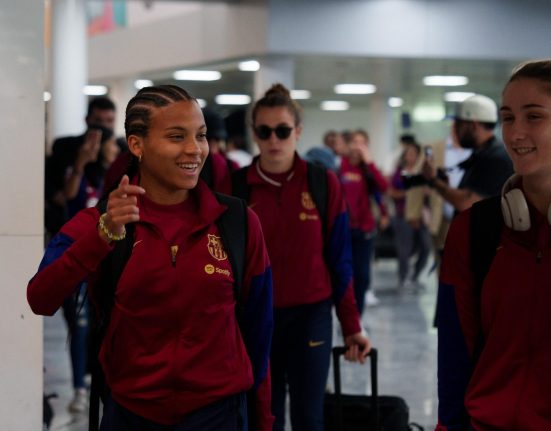
With current injuries to not some, but all, of Barcelona Femení’s first team center-backs, including long-term injury to “Mapi” María León, the club are exploring options to reinforce the position over the winter transfer window.
Barça Femení will not be buying a player for the sake of it in the upcoming January transfer window, but new sporting director Marc Vivés will be keeping an eye on potential center-backs. While Ingrid Engen and Martina Fernández have been performing at the top of the game and both seem destined for the position, neither is nominally a center-back – nobody currently fit in the first squad is. If there is an opportunity to bring one in who, while nobody can match María León’s profile, will add something the team doesn’t already have, the club might take it.
Sport’s Maria Tikas recently looked at some of the options that might catch Vivés’s eye to reinforce Barça Femení over winter, before entering the title-heavy part of the season. But who are they, and what might they bring to the squad?

Besides the four “complicated” options – high-profile players with solid contracts at top teams – Sport lists five more likely players: María Méndez of Levante, Sophia Kleinherne of Eintracht Frankfurt, Maëlle Lakrar of Montpellier, Marthine Østenstad of Brann, and Griedge Mbock of Lyon. Not that these are minor players or at clubs who would let an important starter go too easily, either.
Méndez will be familiar to many of the Barcelona squad, having recently made her debut for Spain under Montse Tomé. She is the captain of Levante and has been essential in their recent good form, but with the club set to reduce their women’s section, she may want to take an early opportunity to find another home. She has a profile more like Irene Paredes (or, now, Engen) than María León, however, and with Paredes back in team training after Christmas, this is a gap that Barça will hopefully not need to fill.
However, she has long been compared to Jana Fernàndez, Barça’s current young Paredes-shaped inheritor. With Jana currently injured, and having been so more often than not for a long time, bringing in Méndez might be not only a way to add defensive depth in the present, but also to prepare for the future if Vivés considers Jana too injury-prone.
Of course, despite having scored for Spain in her scarce minutes with them so far, Méndez would not be considered a forward threat – when she rarely deviates from traditional center-back duties it is more likely to be as a sweeper. Her positional awareness and passing ability (though mostly short to the full-backs or midfield) are outstanding, however, and certainly skills Barcelona could be looking to build on.
Kleinherne is another Paredes-shaped peg that shouldn’t be used to fill a María León-shaped gap. Unlike Paredes, though, Kleinherne poses more of an attacking threat through the middle and sometimes on the wing. Though not a full-back, her attacks in those areas, and her ability to run and cover for attacking full-backs themselves, makes her a versatile defensive option.
While this combination is something Barça will be looking for to reinforce the María León position, Kleinherne comes with a double downside of not only coming from a league unlike Spain’s but also from a team with a heavy reliance on multiple defensive midfielders shielding its center-backs when things get tough. Suffice it to say, Barça prefer to use defensive midfielders in other ways.
And this is perhaps not the fairest judgment, but she was quiet when Frankfurt played Barcelona last month until her poor positioning nearly got her on the scoresheet for Barça. Her positioning was better when her side took on Wolfsburg, but they were of course playing the Bundesliga way.
The adaptation for Kleinherne to Liga F and Barça would be huge, and would need to be swift if she was to prove useful for the rest of the season.
Lakrar is one of the bigger names considered a likely option, and with Barça Femení playing Montpellier in pre-season as reliably as they are at winning those matches, a familiar one, too. She made her France debut at the summer’s World Cup, replacing Mbock. Lakrar and perhaps still Mbock could nowadays be considered the security in defense next to an aging Wendie Renard.
As a center-back, Lakrar’s best comparison would be to the Engens and Leah Williamsons of football, whose defining abilities grew from being a defensive midfield profile too tall, defensive, and not-Keira-Walsh to stay there. Mbock, though having also started her career as a defensive midfielder, has over the years settled into a Paredes or Steph Houghton role, a center-back who will participate in build-up play more often than not through recycling the ball and helping push play forward, unlikely to initiate the attack alone.
The French team play a similar formation, with a similar reliance on ball-playing center-backs, as Barcelona, so either Lakrar or Mbock would hopefully adapt quickly in that respect.
Lakrar stands out for her strong position in defense, on the ball, and in transition, especially for her age. However, she is another player who is unlikely to break lines with her deliveries – something that Walsh and Patri Guijarro can easily do from deep, though they are more useful ahead of the defensive line. She is also weak in 1v1 situations and inconsistent with tackling, so her speed and good interceptions would be the last line of defense against opponents’ counter-attacks that manage to break through a high pressing Barcelona.
Mbock on the other hand is a strong 1v1 defender – perhaps too strong, in that she may devote her attention to man-marking rather than defensive positioning and could easily lose to an attacker simply faster than her modest pace or who comes up while she’s focusing on someone else. At Lyon, she has central midfielders that shield her from such potential errors, much like Kleinherne in Frankfurt.
Lakrar, in another way like Kleinherne, also has the option of covering right-back, too. While Mbock has played there, this has been in a defensive overload system, acting as a center-back out wide rather than using the wing.
The major downside of Mbock is that she is also getting a reputation as injury-prone, and Barça can’t be pulling in more players just to fill their infirmary.
Marthine Østenstad is probably the clearest attack-minded center-back on the list, happy to move into more advanced spaces either on the ball or in anticipation of starting an attacking play. It doesn’t always pay off, but this is where the 22-year-old Østenstad could be moulded into Barça’s preferred profile like her compatriot Engen has.
Because while Brann may have a style of their own, and Østenstad has certainly been strong in their remarkable Champions League run this season, we have mostly seen them respond to their opposition: in this way, she is proving to be a versatile defender with raw ability.
Østenstad, though, was taken off injured around the time Lindsey Horan received her red card in the most recent Champions League game less than a week ago. The hospital is full for winter, but Østenstad would be an exciting future prospect.
If these five are the players we can expect Barcelona to be considering next month, Maëlle Lakrar or María Méndez seem the most promising options to cover a María León absence. While Lakrar may be closer in profile, Méndez is already near the top of the Liga F, which would hopefully ensure a smooth introduction on the pitch.






